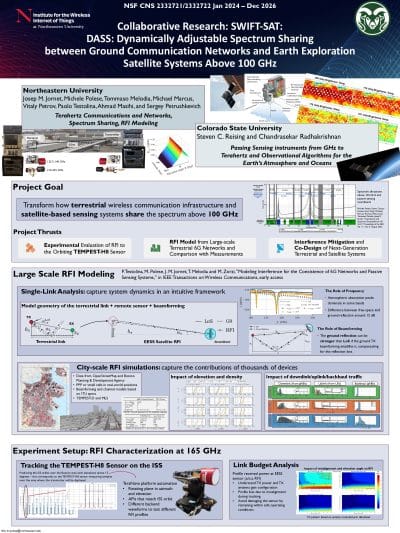Authors
Josep M. Jornet, Steven C. Reising, Michele Polese, Tommaso Melodia, Michael Marcus, Vitaly Petrov, Paolo Testolina, Ahmad Masihi, Sergey Petrushkevich, and Chandrasekar Radhakrishnan
Abstract
The spectrum above 100 GHz is of significant interest for different use cases. Traditionally, the remote sensing community has been interested in measuring specific molecular absorption patterns in multiple narrow sub-bands above 100 GHz. More recently, developments in RF circuitry, antennas, and digital signal processing (DSP) – together with the spectrum crunch in the frequencies traditionally used for wireless networks – have pushed the communications community to consider the large bandwidths potentially available in the sub-THz spectrum for 6G backhaul and access networks. Current spectrum allocations, however, prevent communications networks from using more than 12.5 GHz of contiguous spectrum in the 100-200 GHz range. This is largely to protect passive remote sensing services, which measure natural phenomena and thus cannot tolerate Radio Frequency Interference (RFI). Such a rigid spectrum allocation scheme prevents both services to benefit from larger bandwidths, for faster communication links and for increased precision and opportunities for remote sensing. While this is true for other portions of the spectrum, the characteristics of the propagation, devices, and antennas above 100 GHz make the case for more flexible spectrum sharing and coexistence. The goal of the collaborative project "SWIFT-SAT: DASS: Dynamically Adjustable Spectrum Sharing between Ground Communication Networks and Earth Exploration Satellite Systems Above 100 GHz" is to go beyond traditional, rigid spectrum allocations above 100 GHz and develop innovative coexistence solutions between terrestrial 6G networks and remote sensing satellite systems based on a detailed RFI characterization. The interdisciplinary project team includes experts in sub-THz communications systems and remote sensing with leadership in the development of spectrum sharing solutions, sub-THz testbeds (the TeraNova platform) and millimeter-wave radiometers (the TEMPEST project). In this poster, we describe the activities performed in the first quarter of the project, including (i) detailed data-driven RFI models that aggregate interference from thousands of terrestrial devices, accounting for realistic building obstruction, ground reflection, channel models, topologies, traffic models, and new wavefronts for terrestrial 6G systems, and (ii) the development of a tracking framework to enable experiments with the ISS.

